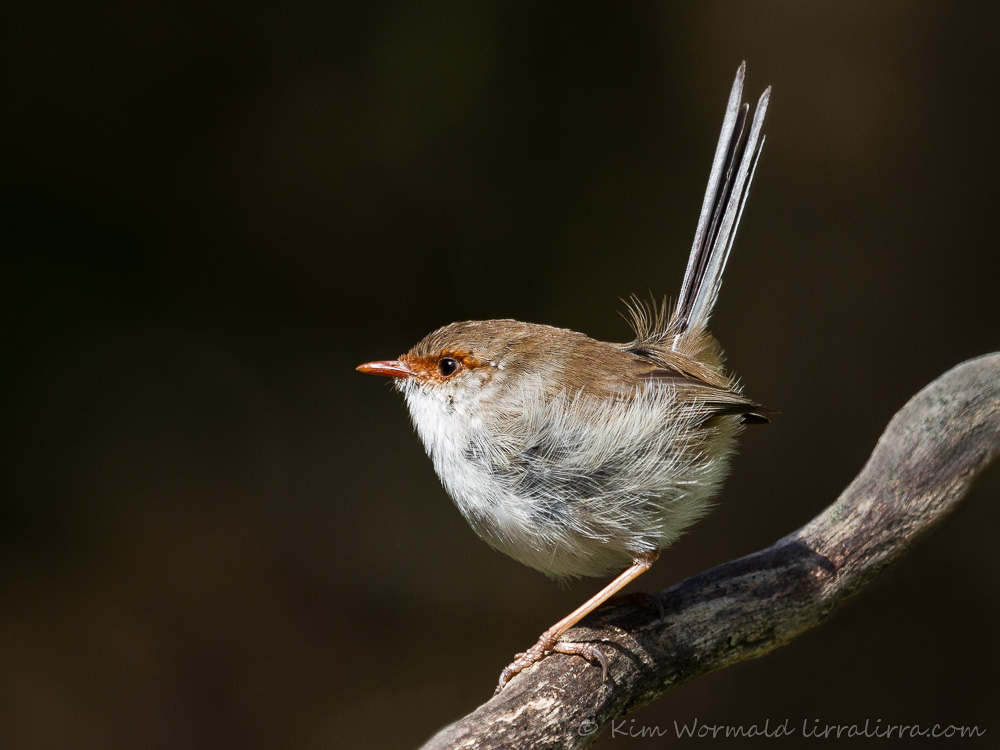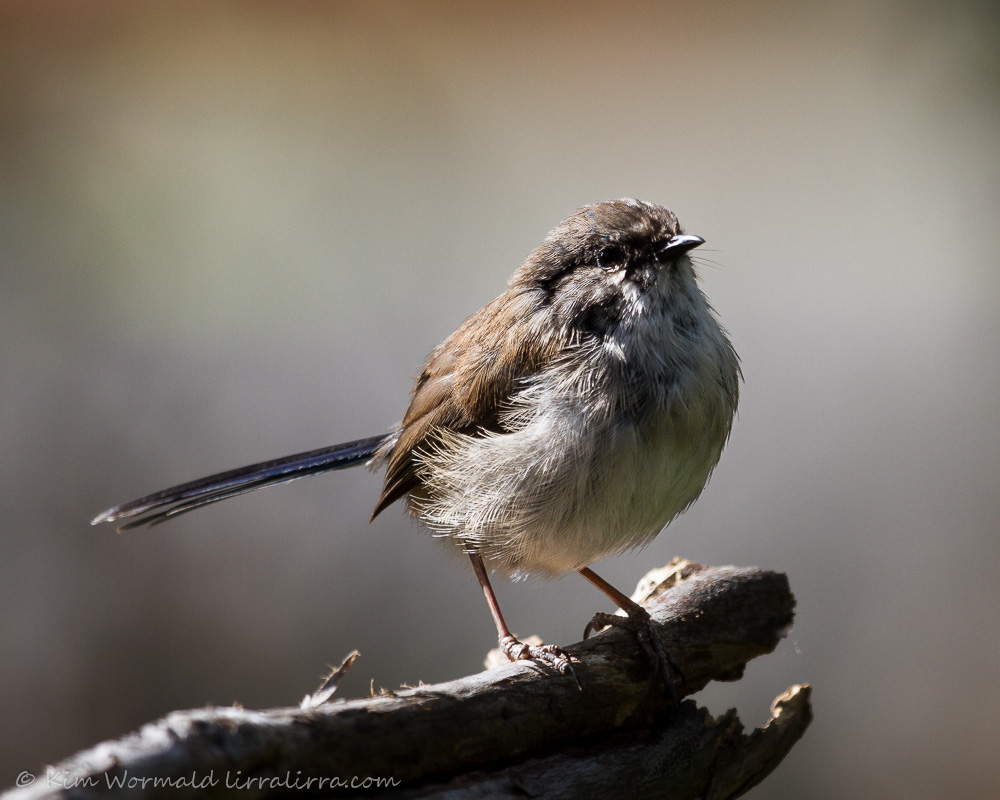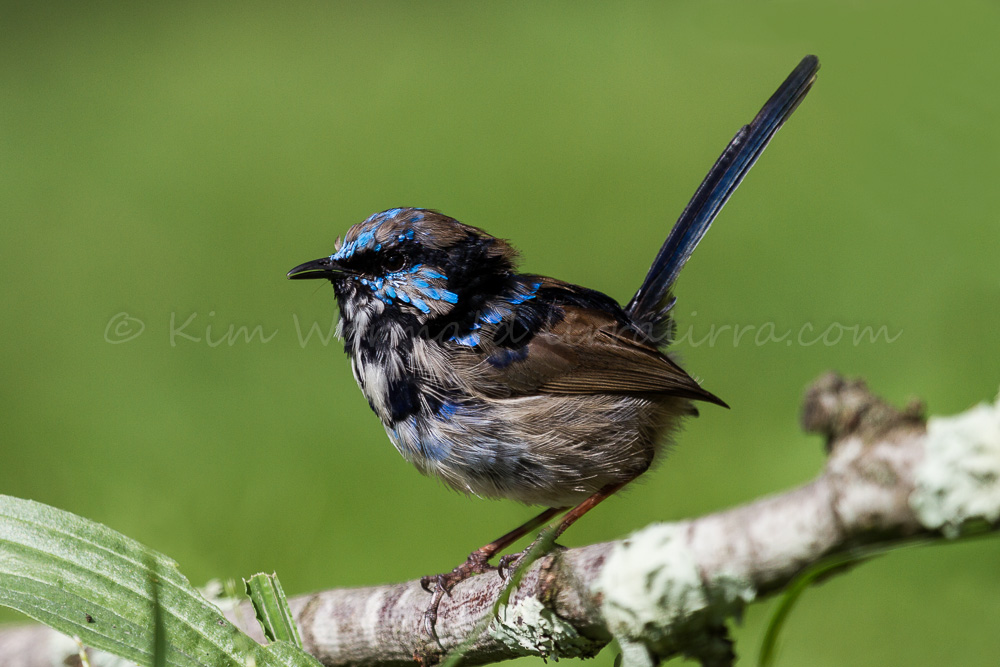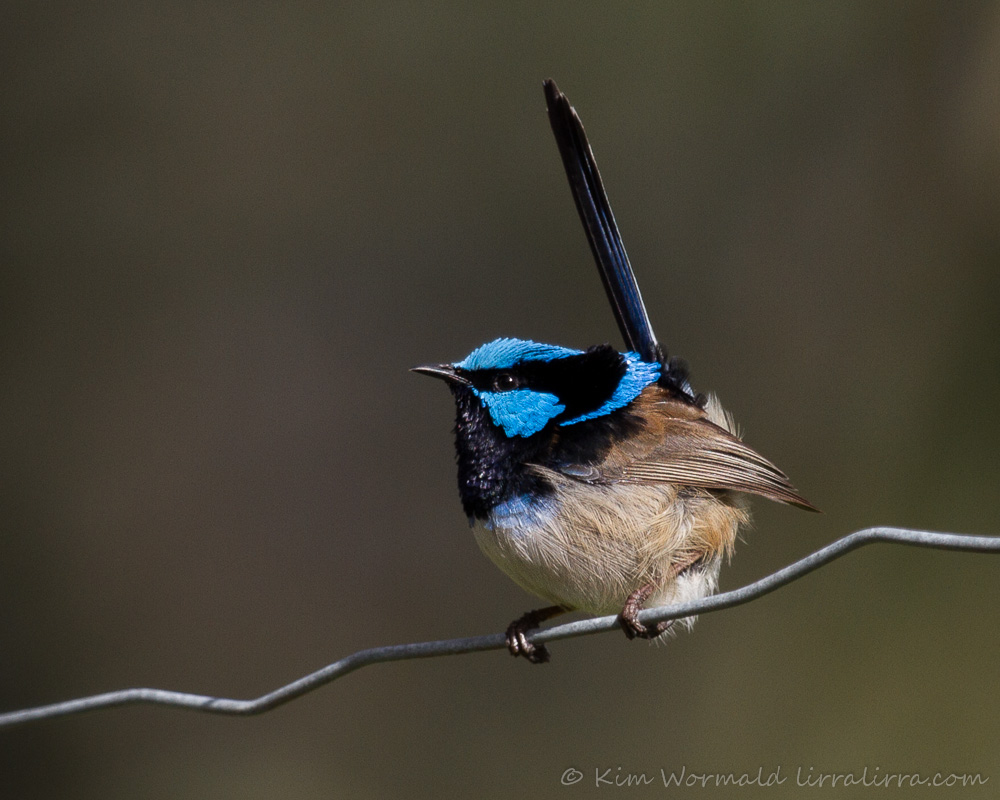Superb Fairy-wrens are one of my favourite little birds. They are usually found foraging in small family groups at ground level or in low shrubs. Despite the males looking so bold in their breeding plumage it is female wrens that rule the roost. Today’s post illustrates the colouring of females, and of males as they move through basic and into full breeding plumage.
 Superb Fairy-wren (Malurus cyaneus) – female
Superb Fairy-wren (Malurus cyaneus) – female
Canon 7D, 100-400mm L IS USM, 1/500, f/5.6, ISO 400, focal length 370mm
When you first start watching Superb Fairy-wrens it can be tricky to identify the females from the non-breeding males, especially as the females’ tails can also be bluish. The best way to confirm that you’re seeing a jenny wren is to note the orange around her eye, the orange lores (the area between the eye and the bill) and the brown bill.
 Superb Fairy-wren (Malurus cyaneus) – non breeding male in basic plumage
Superb Fairy-wren (Malurus cyaneus) – non breeding male in basic plumage
Canon 7D, 100-400mm L IS USM, 1/640, f/5.6, ISO 640, focal length 400mm
The image above is an adult male in non-breeding plumage. His bill is black, juvenile males have brown bills. His tail is quite blue so either it’s the way the light is hitting it or he’s starting to come into breeding colours, or both. Tail colours can look very different depending on how the light hits them, sometimes they are luminescent.
 Superb Fairy-wren (Malurus cyaneus) – male
Superb Fairy-wren (Malurus cyaneus) – male
Canon 7D, 100-400mm L IS USM, 1/640, f/5.6, ISO 320, focal length 400mm
This little chap is just starting to get some blue feathers on his head, they are tiny but you’ll see them if you squint. There is one blue spot just above his eye and another at about 11 o’clock. I could have enhanced the blue to make it clearer but prefer natural images that aren’t over-saturated.
 Superb Fairy-wren (Malurus cyaneus) – male
Superb Fairy-wren (Malurus cyaneus) – male
Canon 7D, 100-400mm L IS USM, 1/640, f/5.6, ISO 125, focal length 365 mm
This mottled fellow is about half way towards full breeding plumage; he looks so scruffy and interesting. The brown and buff colouring on his head and throat are being replaced with black and startlingly bright blue feathers. Just beneath his eye are two pin feathers that are close to unfurling and adding more blue to his cheeks.
 Superb Fairy-wren (Malurus cyaneus) – male, breeding
Superb Fairy-wren (Malurus cyaneus) – male, breeding
Canon 7D, 100-400mm L IS USM, 1/640, f/5.6, ISO 160, focal length 400mm
And finally this handsome fairy-wren is resplendent in full breeding plumage with bright blue and black head, purplish black throat and long blue tail. Studies have shown that female Superb fairy-wrens mate most often with males who do not live in their territory, and that they prefer males who attain full breeding plumage early in the season. Neither of those findings fit with the sightings I had this week of the mottled fellow mating several times with the jenny despite the bird pictured above being nearby. I’m lucky to share my garden with Superb Fairy-wrens, I never tire of watching them.
When I’m out with my camera I notice backgrounds as quickly as I notice birds. Sometimes I want an image that includes the bird’s environment but more often I aim for images that are free from distractions, ideally with a pleasant perch and a blurred background. Often all it takes is to move slightly left or right, or up or down to exclude a distracting area of light or colour behind a bird. These fairy-wren images show four out-of-focus backgrounds and one collection of leaves. Shady areas, trees, grass that has gone to seed and distant bushes can all produce pleasing backgrounds. I aim to get the image right in camera as nature photography focuses on reality rather than post-processing.
Happy birding, Kim
NB It is now possible to receive a weekly email letting you know that lirralirra has been updated – just add your address to the ‘Subscribe to email’ box above right.
Also, I recently added a Facebook ‘like’ button. Thank you to all ‘likers’ – I like you too!

What amazing photos!!
So beautiful!!!!
Thank you for stopping by Rachel, so glad you like the fairywrens, that makes me happy
hi kim
i m just coming back from 2 weeks in holidays near ponds and sea shore, plenty of pictures taken to sort and organise too (pfffff long work in view) happy to see your last pictures there
this bird is too cute, the blue feathers are very unique to see, it s a pleasure to discover yours pictures, thanks and happy birding kim =))
That sounds like a great trip Eric, I look forward to seeing your pictures! Thank you for your kind comments
I would never, ever tire of seeing these beautiful little birds! Thanks for sharing the images of the different plumages, it is fascinating to me.
I love the way that photography lets us enjoy the details without stressing the birds. I love it when they work their way towards me when they’re foraging, but if they work their way away from me that’s fine too!
I love these adorable birds. Both the male and female are beautiful. Wonderful photos, Kim! Have a happy weekend!
I think the jenny is beautiful too! Thanks for your comments, happy weekend to you too. Oh … the fairy-wrens are calling me into the garden right now …
Beautiful plumage! Love the final image
‘Beautiful plumage’ haha! At least none of them are ‘nailed to the perch’. I’m glad you love the final image
Beautiful little birds. I love how brightly you captured the blue. It’s great to see the juvenile colours coming through like that as you can’t see it so clearly with the naked eye.
That’s so true Leanne, one of the things I like best about bird photography is being able to see so many details. Thank you for commenting!
Hello Kim, Love your beautiful photos of the Wrens, they are a special little bird.
Gerald has caught the bird watching bug, this morning he went out with his camera to see if he could spot a
Golden Whistler that he saw yesterday when he was walking the dogs, but didn’t have his camera. He managed to
get a few photos that look quite nice…but the bird was up in the trees, so hard to get a really good photo.
Are you going to show us your award winning photos…
I’m glad you like the fairy-wren images Carole. That’s great about Gerald! Some of the award winners are dotted around the site already but maybe I’ll do a post with the nationals and/or internationals one day, we sure have some beautiful birds in Australia.
I enjoy your writing and photographs, Kim – keep it up. I like the way you showed the two males one after the other; sort of like a ‘before’ and ‘after’.
Thank you Rick, I’m glad that you enjoy lirralirra and appreciate your comments.
Thank you so much for this stunning series. I loved seeing the changes in plumage and have noticed how often bird behaviour doesn’t match what the literature tells us. Obviously the mottled fellow had a silver tongue…
The thought of the mottled fellow having a silver tongue made me laugh! I’m glad you like the series, thanks for your comments.
Love the images. So cool to see all the different variations of coloring. So hard to remember you are now headed into spring there as our birding winds down.
Thanks Sherry. It is odd to think that you are heading for winter, keep warm